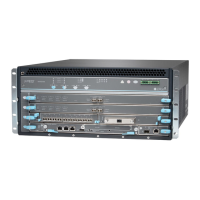LEDs OK/FAIL LED, one bicolor:
• Steady green–The SPC is operang normally.
• Red–The SPC has failed and is not operang normally.
• O–The SPC is powered down.
STATUS LED, one tricolor for each of the four SPUs SPU 0 through SPU 3:
• Green–The SPU is operang normally.
•
Amber–The SPU is inializing.
•
Red–The SPU has encountered an error or a failure.
•
O–The SPU is oine. If all four SPUs are oine, it is safe to remove the SPC from the
chassis.
SERVICE LED, one bicolor for each of the four SPUs SPU 0 through SPU 3:
• Green–Service is running on the SPU under acceptable load.
• Amber–Service on the SPU is overloaded.
• O–Service is not running on the SPU.
HA LED, one tricolor:
• Green–Clustering is operang normally. All cluster members and monitored links are
available, and no error condions are detected.
• Red–A crical alarm is present on clustering. A cluster member is missing or unreachable,
or the other node is no longer part of a cluster because it has been disabled by the dual
membership and detecon recovery process in reacon to a control-link or fabric-link
failure.
• Amber–All cluster members are present, but an error condion has compromised the
performance and resiliency of the cluster. The reduced bandwidth could cause packets to
be dropped or could result in reduced resiliency because a single point of failure might
exist. The error condion might be caused by:
• The loss of chassis cluster links which causes an interface monitoring failure.
• An error in an SPU or NPU.
• Failure of the spu-monitoring or cold-sync-monitoring processes.
18

